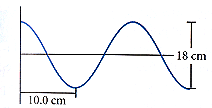
Lisa S. answered • 03/18/23
MS in Physics with 10+ Years of Teaching Experience
(a) You can think of the period of a wave as the time it takes for two successive peaks to pass the same point. On the other hand, you may recall that the frequency of a wave is the number of waves that move past a given point in some length of time. In order to calculate the period, T, we simply take the reciprocal of our frequency, f. In equation form, this means
T = 1/f
If our frequency is f = 31.0 Hz, then the period is
T = 1/31.0 Hz = 0.0323 s.
Therefore, we would count 0.0323 seconds between each peak that passes by a specific location.
(b) The speed of a wave is essentially the speed with which a single peak of the wave moves. In order to calculate this, we need not only the frequency of our wave, but the wavelength, as well.
The wavelength, λ, is the distance between two successive peaks. Looking at the plot above, we can see that half a wavelength is 10.0 cm, which means the full wavelength is λ = 20.0 cm. The speed of the wave is then
v = λf
or the wavelength multiplied by the frequency. Using the values we have, the speed of our wave is
v = (20.0 cm)(31.0 Hz) = 620 cm/s.
That means every second a point on our wave moves 620 cm or 6.2 meters. Wow, that's fast!





